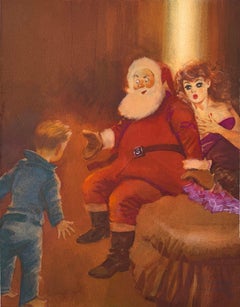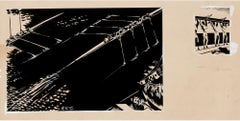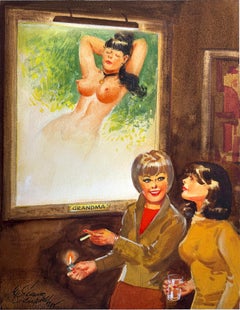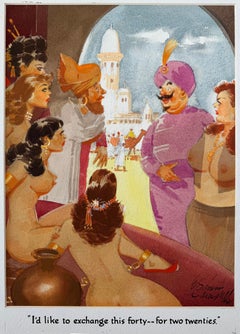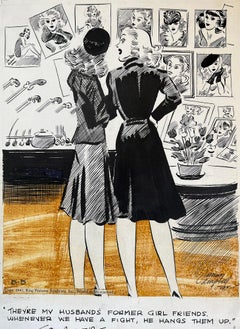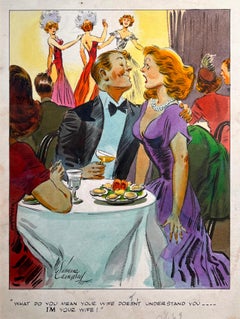E. Simms Campbell Drawings and Watercolor Paintings
American, 1906-1971
Elmer Simms Campbell (January 2, 1906 – January 27, 1971) was an American commercial artist best known as the cartoonist who signed his work, E. Simms Campbell. The first African-American cartoonist published in nationally distributed, slick magazines, he created Esky,the familiar pop-eyed mascot of Esquire. Campbell was born in St. Louis, Missouri, the son of educators, Elizabeth Simms Campbell & Elmer Campbell
He then enrolled in the University of Chicago. After one year, Campbell left the University of Chicago and transferred to and received his degree from the Chicago Art Institute.
He spent two years at Triad Studios before moving to New York City in 1929. taking classes at the National Academy of Design. During this time, he contributed to various magazines, notably Life, & Judge.
Following the suggestion of cartoonist Russell Patterson to focus on good girl art, Campbell created his "Harem Girls", a series of watercolor cartoons that attracted attention in the first issue of Esquire, debuting in 1933. Campbell's artwork was in almost every issue of Esquire from 1933 to 1958 & he was the creator of its continuing mascot, the cartoon character in a silk top hat.
He also contributed to The Chicagoan, Cosmopolitan, Ebony, The New Yorker, Playboy, Opportunity: A Journal of Negro Life, Pictorial Review, and Redbook.
His commercial artwork for advertising included illustrations for Barbasol, Springmaid,Hart Schaffner & Marx.
Campbell also was the author of a chapter on blues music in the 1939 book Jazzmen, a seminal study of jazz's history and development.
Campbell died in White Plains, New York, in 1971
His gag panel, Cuties, was syndicated by King Features in more than 145 newspapers "A Night-Club Map of 1930s Harlem"
Of enduring cultural & historical interest is the witty, cartoon-filled map Campbell drew in 1932 – "A Night-Club Map of 1930s Harlem" identifying the attractions of Harlem during the Harlem Renaissance and adding his personal notes. He captures the intensity of the scene: within a few blocks of each other he has cartooned Cab Calloway singing at the Cotton Club, Bill "Bojangles" Robinson doing his step dance at the Lafayette Theater – "Friday night is the Midnight show, Most Negro revues begin and end here." Lissome "cafe au lait girls" dance at Small's Paradise. Outside, doormen welcome White swells in top hats, while an elegant Black couple in evening dress dance "the Bump"
Campbell's map appears in the book version of Ken Burns's documentary Jazz. The map in its entirety also appears as the inside front cover of "Of Minnie the Moocher and Me", the autobiography of Cab Calloway by Cab Calloway and Bryant Rollins (TY Crowell, 1976). Jazz historian Mike Thibault reports that the original was displayed by the Smithsonian in 1996.The map is currently held at the Yale Beinecke Rare Book & Manuscript Library.
On April 4, 2017, National Geographic published an article on the map that included the map and several enlarged sections of it. They featured it again during 2020 to subscribers of their newsletter, among a collection of unique maps of New York City.
Recognitionto
5
Overall Width
to
Overall Height
to
5
1
1
3
1
1
1
4
1
4
4
3
1
1
1
1
1
1
1
1
1
5
4
4
4
4
6
971
401
359
279
5
Artist: E. Simms Campbell
Santa Claus Sexy Playboy Cartoon First African American Illustrator, Elmer Simms
By E. Simms Campbell
Located in Miami, FL
Santa has a quickie with Mom.
Elmer Simms Campbell was the first African American Illustrator to work for major newsstand magazines.
Published December, 1963
Signed in pencil lower...
Category
1960s Realist E. Simms Campbell Drawings and Watercolor Paintings
Materials
Watercolor, Illustration Board, Pencil
Rowing Sculling Team Regatta, Life Magazine - African American Illustrator
By E. Simms Campbell
Located in Miami, FL
E. Simms Campbell was the first African-American illustrator/ cartoonist published in nationally distributed, slick magazines, he created Esky, the familiar pop-eyed mascot of Esquire. This early work of 1930 was done on assignment for an interior page of Life Magazine. It features two Rowing teams engaged in spirited competition with cheering onlookers. This is a highly stylized black-and-white illustration and is masterfully executed. The work is composed of two illustrations, 6 x 9 inches and 2-3/4 x 2 inches respectively. It is initialed center bottow ESC. unframed
Campbell left the University of Chicago and transferred to and received his degree from the Chicago Art Institute.[3]
Professional career
During a job as a railroad dining-car waiter, Campbell sometimes drew caricatures of the train passengers, and one of those, impressed by Campbell's talent, gave him a job in a St. Louis art studio, Triad Studios.
He spent two years at Triad Studios before moving to New York City in 1929. A month afterward, he found work with the small advertising firm, Munig Studios, and began taking classes at the National Academy of Design.During this time, he contributed to various magazines, notably Life, & Judge
Following the suggestion of cartoonist Russell Patterson to focus on good girl art, Campbell created his "Harem Girls", a series of watercolor cartoons that attracted attention in the first issue of Esquire, debuting in 1933. Campbell's artwork was in almost every issue of Esquire from 1933 to 1958 and he was the creator of its continuing mascot, the cartoon character in a silk top hat.
He also contributed to The Chicagoan, Cosmopolitan, Ebony, The New Yorker, Playboy, Opportunity: A Journal of Negro Life, Pictorial Review, and Redbook.
His commercial artwork for advertising included illustrations for Barbasol, Springmaid, and Hart Schaffner...
Category
1930s E. Simms Campbell Drawings and Watercolor Paintings
Materials
Ink, Illustration Board, Gouache, Pencil
Nude Playboy Cartoon, First African American Illustrator Elmer Simms Campbell
By E. Simms Campbell
Located in Miami, FL
E. Simms Campbell was the first and top black commercial artist in the USA for decades.
In "Grandma," we see a deeply conceptual work, with the blank canvas as the main point of the...
Category
1960s Impressionist E. Simms Campbell Drawings and Watercolor Paintings
Materials
Watercolor, Illustration Board, Pencil
Harem: Sexy Nude Girl Illustration for Playboy. First Black Illustrator
By E. Simms Campbell
Located in Miami, FL
Playboy Magazine ran this joke cartoon illustration in color on page 43 for the October 1960 edition.
Signed lower right.
The work is executed on a heavy Whatman Illustration board....
Category
1960s American Modern E. Simms Campbell Drawings and Watercolor Paintings
Materials
Watercolor, Illustration Board, Pencil, Gouache
My Husbands Former Girl Friends - First Black Illustrator/ Black Cartoonist
By E. Simms Campbell
Located in Miami, FL
Cuties Cartoon Strip - E. Simms Campbell
My Husband Former Girl Friends - First Black Illustrator/ Cartoonist,
Category
1940s Contemporary E. Simms Campbell Drawings and Watercolor Paintings
Materials
Ink, Board
Related Items
Reclining Nude en Plein Aire
By Raymond Debieve
Located in London, GB
'Reclining Nude en Plein Aire', gouache on art paper, by Raymond Debiève (circa 1960s). The reclining figure is one of the most popular poses in art history...
Category
1960s Modern E. Simms Campbell Drawings and Watercolor Paintings
Materials
Paper, Gouache
$1,800 Sale Price
40% Off
H 22.45 in W 26.38 in
Marguerite - 19th Century Pre-Raphaelite Painting of Beauty from Goethe's Faust
By Henry Meynell Rheam
Located in Gerrards Cross, GB
‘Marguerite’ by Henry Meynell Rheam RI (1859-1920). The painting is signed with monogram and dated. Watercolour and gouache on paper, newly remounted, glazed with non-reflective UV r...
Category
Late 19th Century Pre-Raphaelite E. Simms Campbell Drawings and Watercolor Paintings
Materials
Watercolor, Gouache
$8,115
H 24 in W 22 in D 3 in
French Expressive Charcoal Sketch of a Standing Nude Figure
Located in Cirencester, Gloucestershire
Standing Nude Figure
black pen drawing on artist paper
painting: 13.75 x 9 inches
provenance: private collection, England
condition: very good and sound condition
Category
20th Century Impressionist E. Simms Campbell Drawings and Watercolor Paintings
Materials
Ballpoint Pen
$150
H 13.75 in W 9 in D 1 in
"Judy Garland" Legendary Film and Recording Star. Gay Icon. 20th Century Litho
By Albert Al Hirschfeld
Located in New York, NY
"Judy Garland" Legendary Film and Recording Star. Gay Icon. 20th Century Litho
Al Hirschfeld (1903 - 2003)
Judy Garland
20 x 15 inches (sight)
Etching
26 1/2 x 14 3/4 inches Framed...
Category
1970s Performance E. Simms Campbell Drawings and Watercolor Paintings
Materials
Ink, Board
Head of Medusa
Located in Indianapolis, IN
Titled and signed lower center and right.
Category
20th Century E. Simms Campbell Drawings and Watercolor Paintings
Materials
Clay, India Ink, Board
French Pointillist Reclining Male Nude Mid 20th Century Painting
By Louis Bellon
Located in Cirencester, Gloucestershire
Pointillist Reclining Male Nude
by Louis Bellon (French 1908-1998)
initialled lower right
gouache painting on paper, unframed
measurements: 5.5 x 10 inches (overall the sheet measures 8.25 x 11.9 inches)
provenance: private collection of the artists work, Provence, France
Condition report: very good, colour strong, thin paper, margins of sheet show light marks but image is clean
Beautiful Neo-Impressionist 1940's French pointillist...
Category
Mid-20th Century Pointillist E. Simms Campbell Drawings and Watercolor Paintings
Materials
Watercolor, Gouache
$1,227
H 5.5 in W 10 in
Neoclassical composition of a sculptor kneeling before his statue of the Madonna
Located in Middletown, NY
An allegory of loyalty, with the subject's dog pictured seated, holding his master's chisel in his mouth; fidelity personified.
Italian School, 18th century
Ink wash in gray and bl...
Category
Mid-18th Century Italian School E. Simms Campbell Drawings and Watercolor Paintings
Materials
Laid Paper, Ink, Watercolor
$500
H 9.73 in W 7.01 in
We Love You, drawing on engraving signed & inscribed unique variant X/X, Framed
By Louise Bourgeois
Located in New York, NY
Louise Bourgeois
We Love You, 2000
Engraving and watercolor with unique Ink drawing on Fabriano Paper
Unique Variant with original hand coloring)
Signed by the artist, inscribed "X" ...
Category
Early 2000s Abstract E. Simms Campbell Drawings and Watercolor Paintings
Materials
Ink, Watercolor, Pencil, Graphite, Engraving
French Vintage portrait of a nude by Antoine Calbet - pastel signed
By Antoine Calbet
Located in PARIS, FR
Mint condition, vivid colors.
Free US CONTINENTAL shipping, incl Europe and Asia.
Antoine Calbet: A Master of Academic Realism in the Third Republic
A Distinguished Journey
Antoine...
Category
Late 19th Century Impressionist E. Simms Campbell Drawings and Watercolor Paintings
Materials
Gouache, Pastel
$1,613
H 12.68 in W 9.45 in
Nude Woman Drying Her Hair
By Raymond Debieve
Located in London, GB
'Nude Woman Drying Her Hair', crayon and pencil on fine paper (1967), by Raymond Debiève (1931 - 2011). A shapely woman has just finished bathing and is drying her hair in the privac...
Category
1960s Modern E. Simms Campbell Drawings and Watercolor Paintings
Materials
Paper, Oil Crayon, Graphite
Making Love Series I, Nude Drawing, Pen & Ink Paper Pasted on Board "In Stock"
By Sunil Das
Located in Kolkata, West Bengal
Sunil Das - Making Love Series I - 9 x 7 inches (unframed size)
Pen and Ink on Paper Pasted on Board
Shipment without frame .
Sunil Das (1939-2015) was a Master Modern Indian Artist...
Category
2010s Modern E. Simms Campbell Drawings and Watercolor Paintings
Materials
Paper, Ink, Pen, Board
$960 Sale Price
20% Off
H 17 in W 15 in D 1 in
Study of a Seated Figure from Behind Pencil Sketch
Located in Cirencester, Gloucestershire
Study of a Seated Figure
pencil drawing on artist paper
painting: 11 x 8.25 inches
double sided
provenance: private collection, England
condition: very good and sound condition
Category
20th Century Impressionist E. Simms Campbell Drawings and Watercolor Paintings
Materials
Pencil
Previously Available Items
"What do you mean your wife" First African American Illustrator - Black Artist
By E. Simms Campbell
Located in Miami, FL
E. Simms Campbel was the first major African American Illustrator. He did covers for Esquire Magazine starting in the 1930s.
He created the famou...
Category
1950s Academic E. Simms Campbell Drawings and Watercolor Paintings
Materials
Ink, Watercolor, Board
E. Simms Campbell drawings and watercolor paintings for sale on 1stDibs.
Find a wide variety of authentic E. Simms Campbell drawings and watercolor paintings available for sale on 1stDibs. You can also browse by medium to find art by E. Simms Campbell in board, ink, paint and more. Much of the original work by this artist or collective was created during the 20th century and is mostly associated with the contemporary style. Not every interior allows for large E. Simms Campbell drawings and watercolor paintings, so small editions measuring 9 inches across are available. Customers who are interested in this artist might also find the work of Eliane Diverly, Joanne Grune-Yanoff, and Shaun O'Dell. E. Simms Campbell drawings and watercolor paintings prices can differ depending upon medium, time period and other attributes. On 1stDibs, the price for these items starts at $6,500 and tops out at $7,000, while the average work can sell for $7,000.
